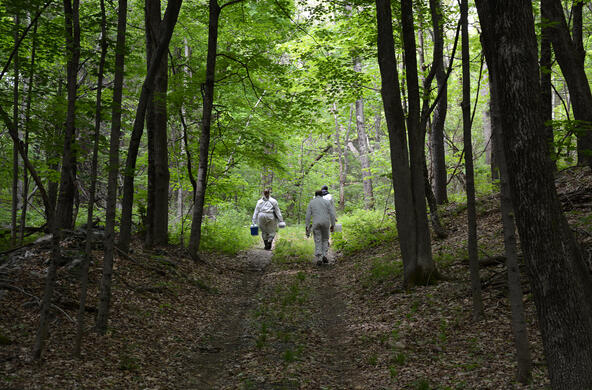Millbrook, NY - Imported forest pests cause billions of dollars in damages each year, and U.S. property owners and municipalities foot most of the bill. Efforts to prevent new pests are not keeping pace with escalating trade and must be strengthened if we are to slow the loss of our nation’s trees. So reports a team of 16 scientists in a new paper published online today in the journal Ecological Applications.
Dr. Gary Lovett, a forest ecologist at the Cary Institute of Ecosystem Studies and the paper’s lead author, explains, “Imported forest pests are the most pressing and underappreciated forest health issue in the U.S. today. We need to act now to strengthen prevention if we are going to protect billions of valuable trees in communities and forests all across the U.S.”
The paper is the most comprehensive synthesis to date on forest pests, covering ecological and economic impacts and evaluating policy solutions. Co-authors include scientists from Harvard Forest, the USDA Forest Service, The Nature Conservancy, Dartmouth College, McGill University, and Michigan State. The Science Policy Exchange, a consortium focused on synthesizing ecological science for decision- making, convened the group.
Emerald ash borer, Asian longhorned beetle, hemlock woolly adelgid, sudden oak death – these are just a handful of the imported insects and diseases killing U.S. trees. Most arrived as stowaways in international cargo. Each year, 25 million shipping containers enter the U.S.; thousands have forest pests lurking among their goods. Major pathways of forest pest introductions are solid wood packing material, such as pallets and crates, and live plants bound for the nursery trade.

Imported forest pests cause more than $2 billion in damages each year. The problem is widespread, with pests present in all 50 states. New York, Massachusetts, Ohio, Michigan, California, Idaho, North Carolina and Florida are among the hardest hit. Sixty-three percent of U.S. forestland, or 825 million acres, are at risk of increased damage from established pests. Urban and suburban trees are the costliest casualties. Removal and replanting are expensive, and loss of trees from streets, yards, and parks affects property values, cooling, flooding, air quality, and aesthetics.
“When the Asian longhorned beetle struck Worcester, Massachusetts, more than 34,000 trees were removed. It looked like a hurricane had struck the city,” said David Orwig, a Senior Ecologist at Harvard Forest. “It will take decades or more for the community to recover the benefits of the trees.”
The stakes are higher than most people realize. Forest pests are the only threat that can decimate an entire tree species within just decades. They virtually eliminated American chestnuts from our forests and stately American elms from our streets. The loss of trees has heightened significance today as communities turn to trees as “green infrastructure” to help mitigate and adapt to climate change.
Current policies will still allow a wave of new pests to invade the country in the coming decades. Strengthening prevention would shift the economic burden of dealing with these pests from property owners and municipalities back to the importers and shippers responsible for introducing them. It also offers the best hope for limiting future invasions, and yields significant savings for communities and taxpayers. Current policies are projected to return $11 billion in net benefits by 2050, with the study’s authors projecting larger benefits with stronger prevention efforts.

Dr. Lovett is leading an alliance of scientists promoting Tree-SMART Trade, a series of five high-priority policy actions identified by the research. These prevention measures target the pathways that transmit pests. If adopted, they would dramatically reduce the arrival and establishment of new forest pests.
Lovett explains, “While existing measures to thwart forest pests have helped, we still see introductions of new pests every year. The good news is that we can do more to prevent new forest pests from arriving and establishing. That is the focus of Tree-SMART Trade.”
More than 90% of wood boring insects that have recently invaded the U.S. entered in wood packaging. The top Tree-SMART Trade action is adoption of alternatives to solid wood packaging, such as plywood or strand lumber. Switching to non-solid-wood packaging could reduce pests and result in large economic benefits.
Historically, 70% of forest pests arrived in the U.S. on imported plants. Ending or greatly limiting imports of live trees and shrubs that share a genus or species with plants native to the U.S. is another high- impact option identified by the researchers. Intercepting pests by improving early detection programs in the U.S. and strengthening pest prevention programs with trading partners abroad are two additional priorities. The fifth Tree-SMART Trade action is tightening trade enforcement guidelines. Current guidelines allow importers to violate wood packaging treatment requirements five times each year before facing penalties.
According to the study, taking action to prevent new forest pests will alleviate the economic burden borne disproportionately by homeowners and municipalities while safeguarding U.S. trees and the valuable benefits they provide to our forests and communities.
Citation
Lovett, G.M., Weiss, M., Liebhold, A., Holmes, T.P., Leung, B., Lambert, K.F., Orwig, D.A., Campbell, F.T., Rosenthal, J., McCullough, D.G., Wildova, R. Ayres, M.P., Canham, C.D., Foster, D.R., LaDeau, S.L., Weldy, T. 2016. Non-Native Forest Insects and Pathogens in the US: Impacts and Policy Options. Ecological Applications. DOI 10.1890/15-1176.1
This research was supported by the Doris Duke Charitable Foundation, the F.M. Kirby Foundation, and Northeastern States Research Cooperative of the USDA Forest Service.
To receive an embargoed copy of the paper and supporting maps, infographics, video, and photos please contact: quillenl@caryinstitute.org or marissaweiss@fas.harvard.edu.
The paper and full press kit will be available at www.caryinstitute.org/tree-smart-trade on May 10, at approximately 11:00 am US EST.
Follow updates on twitter @caryinstitute, @scixpolicy
Available for interviews:
- Gary Lovett, PhD, Forest Ecologist and Senior Scientist, Cary Institute of Ecosystem Studies
- David Orwig, PhD, Senior Ecologist, Harvard Forest, Harvard University
- Deborah McCullough, PhD, Professor of Entomology and Forestry, Michigan State University
- David Foster, PhD, Director, Harvard Forest, Harvard University
- Other outside experts are also available for comment
The Cary Institute of Ecosystem Studies is one of the world’s leading independent environmental research organizations. Areas of expertise include disease ecology, forest and freshwater health, climate change, urban ecology, and invasive species. Since 1983, Cary Institute scientists have produced the unbiased research needed to inform effective management and policy decisions.
Harvard Forest is a department of the Faculty of Arts and Sciences of Harvard University and a Long-Term Ecological Research Site for studying forest dynamics over time. Scientists at the Forest explore topics ranging from conservation and environmental change to land-use history and the ways in which physical, biological and human systems interact to change our earth.
Non-Native Forest Insects and Pathogens in the U.S. is a project of the Science Policy Exchange, a consortium of ecological research institutions that seeks to synthesize science for decision-making.







